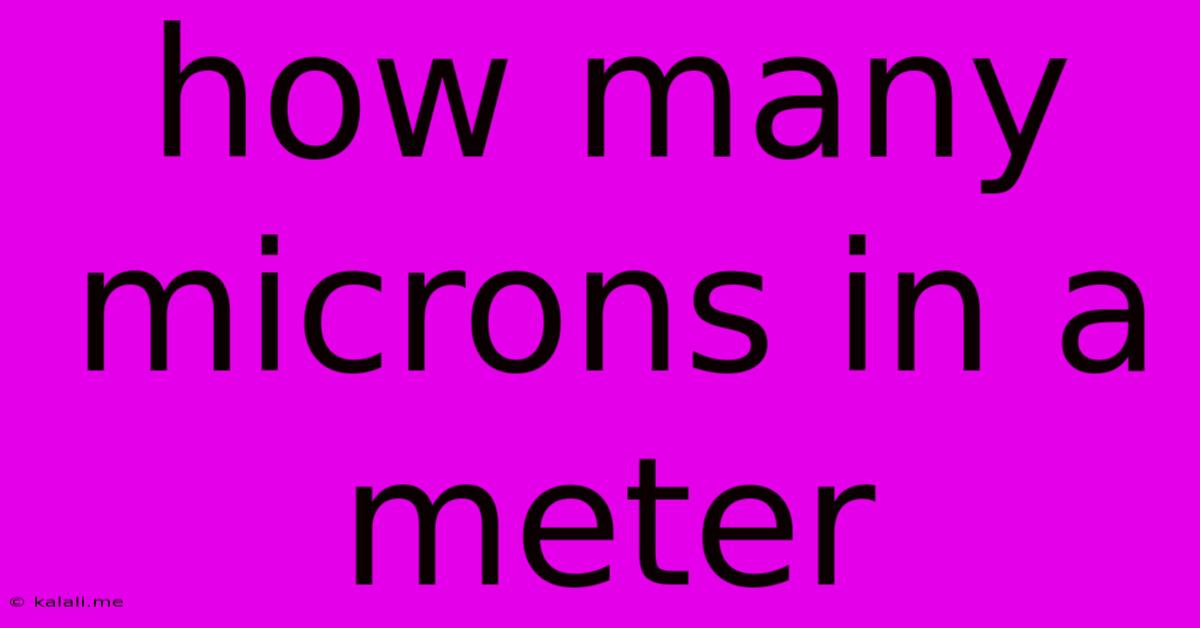How Many Microns In A Meter
Kalali
Jun 13, 2025 · 2 min read

Table of Contents
How Many Microns in a Meter? A Comprehensive Guide to Micrometer Conversions
Understanding the relationship between microns (micrometers) and meters is crucial in various fields, from engineering and manufacturing to microscopy and materials science. This guide will clearly explain the conversion, provide helpful examples, and explore the significance of this unit of measurement.
What is a Micron (Micrometer)?
A micron, or micrometer (µm), is a unit of length in the metric system. It's one millionth of a meter (10⁻⁶ meters). Think of it as an incredibly tiny unit, often used to measure things invisible to the naked eye, such as the thickness of a human hair or the size of bacteria.
The Conversion: Microns to Meters
The fundamental conversion is straightforward:
- 1 meter (m) = 1,000,000 microns (µm)
Therefore, to convert microns to meters, you simply divide the number of microns by 1,000,000. Conversely, to convert meters to microns, you multiply the number of meters by 1,000,000.
Examples of Micron to Meter Conversions
Let's illustrate with a few practical examples:
-
Example 1: A sheet of paper is approximately 100 µm thick. To convert this to meters: 100 µm / 1,000,000 µm/m = 0.0001 m.
-
Example 2: A red blood cell has a diameter of roughly 7 µm. Converting this to meters: 7 µm / 1,000,000 µm/m = 0.000007 m.
-
Example 3: A human hair's diameter can range from 17 to 180 µm. Let's take the average of 100 µm. Converting to meters: 100 µm / 1,000,000 µm/m = 0.0001 m. This illustrates how small a micron is compared to a meter.
Why Understanding Micron to Meter Conversions is Important
Precision in measurement is paramount in numerous applications. Knowing how to convert between microns and meters is vital for:
-
Manufacturing: Ensuring the precise dimensions of components in microelectronics, nanotechnology, and other high-precision industries. Tolerance levels are often expressed in microns.
-
Materials Science: Characterizing the properties of materials at a microscopic level, such as grain size analysis and surface roughness measurement.
-
Microscopy: Interpreting images and measurements obtained from microscopes, which often utilize micron-scale measurements.
-
Medicine: Analyzing blood cell sizes, bacterial dimensions, and other crucial biological parameters.
-
Engineering: Designing and manufacturing extremely small, precise parts and mechanisms.
Conclusion:
Mastering the conversion between microns and meters is a fundamental skill for anyone working with small-scale measurements. Remember the key conversion factor: 1 meter equals 1,000,000 microns. By understanding this relationship, you can effectively navigate the world of microscopic measurements and contribute to advancements in various scientific and engineering disciplines. This understanding also helps in accurately interpreting data and specifications related to these tiny units of length.
Latest Posts
Latest Posts
-
Which Of The Following Is A Connectionless Protocol
Jun 14, 2025
-
Cooling Of Magma On Earths Surface
Jun 14, 2025
-
Relation Between Linear Acceleration And Angular Acceleration
Jun 14, 2025
-
Which Of The Following Statements About Government Is True
Jun 14, 2025
-
What Type Of Electromagnetic Wave Has The Longest Wavelength
Jun 14, 2025
Related Post
Thank you for visiting our website which covers about How Many Microns In A Meter . We hope the information provided has been useful to you. Feel free to contact us if you have any questions or need further assistance. See you next time and don't miss to bookmark.